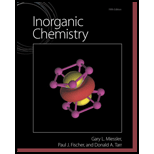
Inorganic Chemistry
5th Edition
ISBN: 9780321811059
Author: Gary L. Miessler, Paul J. Fischer, Donald A. Tarr
Publisher: Prentice Hall
expand_more
expand_more
format_list_bulleted
Textbook Question
Chapter 3.2, Problem 3.6E
Does this approach work for different steric numbers?
Expert Solution & Answer
Trending nowThis is a popular solution!

Students have asked these similar questions
What are the major products of the following reaction?
Draw all the major products. If there are no major products, then there is no reaction that will take place. Use wedge and dash bonds when necessary.
Tryptophan is an essential amino acid important in the synthesis of neurotransmitter serotonin in the body. What are the hybridization states, molecular geometry and approximate bond angle at the indicated carbon and nitrogen atoms?
Please provide a thorough explanation that allows for undertanding of topic.
Can the target compound be efficiently synthesized in good yield from the substituted benzene of the starting material?
If yes, draw the synthesis. Include all steps and all reactants.
Chapter 3 Solutions
Inorganic Chemistry
Ch. 3.1 - Use electron-dot diagrams and formal charges to...Ch. 3.2 - Predict the structures of the following ions....Ch. 3.2 - Prob. 3.3ECh. 3.2 - Which molecule has the smallest bond angle in each...Ch. 3.2 - Briefly account for the following observations: a....Ch. 3.2 - Does this approach work for different steric...Ch. 3 - The dimethyldithiocarbamate ion, [S2CN( CH 3 )2]-...Ch. 3 - Several resonance structures are possible for each...Ch. 3 - Draw the resonance structures for the...Ch. 3 - Three isomers having the formula N2CO are known:...
Ch. 3 - Show the possible resonance structures for nitrous...Ch. 3 - Nitric acid, which exists as HNO3 molecules in the...Ch. 3 - L. C. Allen has suggested that a more meaningful...Ch. 3 - Give Lewis dot structures and sketch the shapes of...Ch. 3 - Give Lewis dot structures and sketch the shapes of...Ch. 3 - Give Lewis dot structures and sketch the shapes of...Ch. 3 - Explain the trends in bond angles and bond lengths...Ch. 3 - Select from each set the molecule or ¡on having...Ch. 3 - a. Compare the structures of the azide ion, N3 ,...Ch. 3 - Consider the series OCl2,O( CH3)2 , and O( SiH3)2...Ch. 3 - Two ions isoelectronic with carbon suboxide, C3O2...Ch. 3 - Explain the following: a. Ethylene, C2H4 , is a...Ch. 3 - Explain the following: a. PCI5 is a stable...Ch. 3 - X-ray crystal structures of ClOF3 and BrOF3 have...Ch. 3 - Make the following comparisons about the molecules...Ch. 3 - Prob. 3.20PCh. 3 - A solution containing the lO2F2 ion reacts slowly...Ch. 3 - The XeOF3 anion has been reported recently (D. S....Ch. 3 - Predict the structure of l(CF3)Cl2 . Do you expect...Ch. 3 - a. Which has the longer axial PF distance, PF2(...Ch. 3 - Prob. 3.25PCh. 3 - SeCl62,TeCl62 , and CIF6 are all octahedral, but...Ch. 3 - Prob. 3.27PCh. 3 - The thiazyldichloride ion, NSCl2- , is...Ch. 3 - Sketch the most likely structure of PCl3Br2 and...Ch. 3 - a. Are the CF3 groups in PCl3( CF3)2 more likely...Ch. 3 - Of the molecules C1SO2CH3,C1SO2CF3 , and ClSO2CCl3...Ch. 3 - Prob. 3.32PCh. 3 - Prob. 3.33PCh. 3 - Prob. 3.34PCh. 3 - Prob. 3.35PCh. 3 - Although the CF distances and the FCF bond angles...Ch. 3 - The Cl...Cl distance in CCl4 is 289 pm, and the...Ch. 3 - The FCF angle in F2CO , shown here, is 109.5°; the...Ch. 3 - Compounds in which hydrogen is the outer atom can...Ch. 3 - For each of the following bonds, indicate which...Ch. 3 - Give Lewis dot structures and shapes for the...Ch. 3 - Give Lewis dot structures and sketch the shapes...Ch. 3 - Which of the molecules in Problem 3.41 are polar?Ch. 3 - Which of the molecules in Problem 3.42 are polar?Ch. 3 - Prob. 3.45PCh. 3 - Prob. 3.46P
Knowledge Booster
Learn more about
Need a deep-dive on the concept behind this application? Look no further. Learn more about this topic, chemistry and related others by exploring similar questions and additional content below.Similar questions
- What are the major products of the following reaction? Draw all the major products. If there are no major products, then there is no reaction that will take place. Use wedge and dash bonds when necessary.arrow_forwardCan the following molecule be made in good yield from no more than two reactants, by moderately heating the reactants? If yes, draw the reactant or reactants. If no, then the product can't be made in one step.arrow_forwardDon't used Ai solutionarrow_forward
- using dimensional analysis convert 0.00685 km to micrometersarrow_forwardWhat are the major products of the following reaction? Draw all the major products. If there are no major products, then there is no reaction that will take place. Use wedge and dash bonds when necessary.arrow_forwardcalculation based on mole-mole relationshiparrow_forward
arrow_back_ios
SEE MORE QUESTIONS
arrow_forward_ios
Recommended textbooks for you
 Principles of Instrumental AnalysisChemistryISBN:9781305577213Author:Douglas A. Skoog, F. James Holler, Stanley R. CrouchPublisher:Cengage Learning
Principles of Instrumental AnalysisChemistryISBN:9781305577213Author:Douglas A. Skoog, F. James Holler, Stanley R. CrouchPublisher:Cengage Learning

Principles of Instrumental Analysis
Chemistry
ISBN:9781305577213
Author:Douglas A. Skoog, F. James Holler, Stanley R. Crouch
Publisher:Cengage Learning

Thermogravimetric Analysis [ TGA ] # Thermal Analysis # Analytical Chemistry Part-11# CSIR NET/GATE; Author: Priyanka Jain;https://www.youtube.com/watch?v=p1K-Jpzylso;License: Standard YouTube License, CC-BY